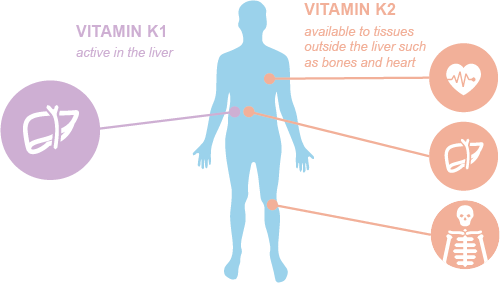heading_title

If we were to name 1 nutrient that is most deficient in our society, it would be vitamin D3. Its supplementation is recommended for almost everyone during the fall and winter, and increasingly even year-round supplementation is recommended.
A good practice to increase the safety of supplementation, but also to compound the benefits, is to use vitamin D3 in company with vitamin K2. Let's discuss in turn why to use these vitamins and why it's a good idea to take them at the same time.
- How does vitamin D3 work?
- How does vitamin K2 work?
- Vitamin D3 deficiency affects a significant portion of the population
- Synergy of vitamins D3 and K2
- Which is the best vitamin D3 with K2?
How does vitamin D3 work?
Vitamin D is called the sunshine vitamin. This warm term has clung to it because of the method of its synthesis. Namely, it is produced in the skin as a result of exposure to sunlight, specifically UV-B rays. On the skin, cholecalciferol is formed (which is the same form we consume in supplements), then it is converted in the liver to calcidiol (25(OH)D3, this form is usually tested in the blood), and later in the kidneys to the actual active form of vitamin D3, which is calcitriol (1,25(OH)2D3).
Studies confirm the possible role of vitamin D in the fight against:
- cancer,
- heart disease,
- fractures and falls,
- autoimmune diseases,
- influenza,
- type 2 diabetes,
- depression.
Vitamin D stimulates the absorption of calcium and phosphorus from the intestines and is essential for their proper utilization. In the absence of vitamin D availability, only 10-15% of calcium and about 60% of phosphorus are absorbed. Adequate vitamin D increases calcium absorption by 30-40% and phosphorus absorption by 80%. Proper bone mineralization is the main goal of vitamin D supplementation.
This is why for decades newborns have been given vitamin D3 in the first days of life. Without it, the risk of bone development defects (such as rickets) increases.
Today, recommendations for the use of vitamin D have expanded considerably to include all age groups, as well as higher doses than originally indicated. The active form of vitamin D regulates the activity of about 200 genes. It affects:
- bones,
- intestines,
- the immune system,
- cardiovascular system,
- pancreas,
- muscles,
- brain,
- control of cell cycles.
It affects many biological processes, including:
- inhibiting cell proliferation and inducing terminal differentiation,
- inhibiting angiogenesis,
- stimulating insulin production,
- inhibiting renin production,
- stimulating macrophage cathelicidin production.
Interesting fact: due to its steroidal structure and the presence of vitamin D receptors in most tissues, it is considered a hormone.
How does vitamin K2 work?
The action of vitamin K2 is slightly different from ordinary vitamin K (which is customarily referred to vitamin K1). It is more involved in regulating bone health, while vitamin K1, as most of you know, mainly affects blood clotting. Experts estimate that vitamin K2 supplementation does not cause the risk of hypercoagulability. On the other hand, even long-term vitamin K1 supplementation (3 years) does not affect bone mineral density.
 Source: https://www.nutraingredients-usa.com/News/Promotional-Features/Vitamin-K2-Potential-Impact-Beyond-Bone-Cardiovascular-Health
Source: https://www.nutraingredients-usa.com/News/Promotional-Features/Vitamin-K2-Potential-Impact-Beyond-Bone-Cardiovascular-Health
Vitamin K2 is involved in calcium transport, preventing calcium deposition in the lining of blood vessel walls, and helps improve bone density. It achieves this by, among other things, activating the vitamin K-dependent protein MGP (Matrix GLa protein). Vitamin K2 (MK-7) from fermented soybeans stimulates osteoblasts (bone-forming cells) and inhibits osteoclasts (bone-depleting cells), causing an anabolic effect on bone tissue. When vitamin K2 levels are raised, carboxylated osteocalcin also increases.
We can summarize this package of expert-sounding actions in simple words: thanks to K2, calcium is used much more efficiently to strengthen bones.
Vitamin D3 deficiency affects a significant portion of the population
Vitamin D deficiency affects nearly 50% of the population worldwide. An estimated 1 billion people worldwide, of all ethnic and age groups, are vit D deficient.
Reference standards for vitamin D3 blood levels are as follows:
- <20 ng/ml - deficiency
- 20-30 ng/ml - low levels
- 30-50 ng/ml - normal level
- 50-100 ng/ml - elevated levels
- 100-150 ng/ml - potential toxicity
- >150 ng/ml - toxic value
Measures aimed at reducing the statistics of vitamin D deficiency are in the interest of society as a whole. Its supplementation is a low-cost treatment, and the health benefits including reduced risk of many chronic diseases of civilization are extremely attractive. Increasing public awareness of the issue can save a significant percentage of the public health care budget.

Symptoms of vitamin D deficiency
Vit D3 deficiency has no specific manifestations, and its symptoms can be attributed to many other conditions and ailments. Therefore, without a vitamin 25(OH)D3 concentration test, it is extremely difficult to diagnose vitamin D3 deficiency. The best known symptoms are:
- bone fragility and brittleness,
- muscle weakness
- mood disorders,
- more frequent falls in seniors,
- deterioration of immunity,
- autoimmune diseases,
- osteoporosis.
Causes of vitamin D deficiency
Probably the biggest problem is insufficient exposure to the sun during the hours with the highest availability of UV-B rays, but there are also several other suspected factors. In brief summary, potential causes of vit D deficiency are:
- low outdoor activity between 10 am and 3 pm,
- air pollution, limiting access to UV rays,
- low vitamin D content in foods,
- dark complexion (reduces the rate of production of the vitamin),
- use of certain medications (including anticonvulsants or those used for HIV/AIDS),
- granulomatous diseases,
- bariatric surgery,
- impaired fat absorption.
Synergy of vitamins D3 and K2
Why are these two vitamins used together? Well, together they provide greater bone and cardiovascular health benefits, and in some ways using them together is supposed to reduce the risks of supplementing vitamin D3 separately, especially in high doses with concurrent, undiagnosed K2 deficiency. At issue is a situation in which rapidly supplemented vitamin D3 begins to increase the availability of calcium, and the biochemical environment is unable to use it at an adequate rate to increase bone mineralization. There is a risk that circulating calcium will feed into soft tissues instead of bones and increase their fragility, worsening circulation and increasing the risk of atherosclerosis. Vascular calcification has been linked precisely to vitamin K2 deficiency.
As the researchers conclude, vitamin K2 may be a useful adjunct in the treatment of osteoporosis, and when combined with vitamin D and calcium, it rivals bisphosphonate therapy (the standard group of drugs) without toxicity. It can also significantly reduce vascular calcification, reducing the risk of cardiovascular disease and mortality from it. Vitamin K2 appears promising in the context of diabetes, cancer and osteoarthritis, with which vitamin D3 is also sometimes helpful.
In summary, vitamin D3 and K2 share many common areas of action in the human body, and taking them at the same time minimizes the risk of calcification of blood vessels.
Which is the best vitamin D3 with K2?
Especially recommended are those of natural origin. Natural vitamin D3 is derived from sheep lanolin, and natural vitamin K2 is in the form of fermented natto extract.
Vitamin K2 should be the MK7 (menaquinone-7) variant. Sometimes the MK4 variant is used, which has the same functions, but also a shorter duration of action, so MK7 is the preferred form.
Dosages in the formula should be selected individually, and unfortunately it is impossible to point to a one-size-fits-all regimen that will be good for everyone.
The market abounds in supplements with these vitamins. It's a good idea to choose D3K2 capsules or tablets from manufacturers with a good reputation and long standing on the market, to minimize the risk of coming across poor quality.
Sources:
- Nair R, Maseeh A. Vitamin D: The "sunshine" vitamin. J Pharmacol Pharmacother. 2012 Apr;3(2):118-26. doi: 10.4103/0976-500X.95506. PMID: 22629085; PMCID: PMC3356951.
- Schwalfenberg GK. Vitamins K1 and K2: The Emerging Group of Vitamins Required for Human Health. J Nutr Metab. 2017;2017:6254836. doi: 10.1155/2017/6254836. epub 2017 Jun 18. PMID: 28698808; PMCID: PMC5494092.
 ⮜ Previous article
⮜ Previous article
Sodium butyrate - what is it and what is its use?
 Next article ⮞
Next article ⮞